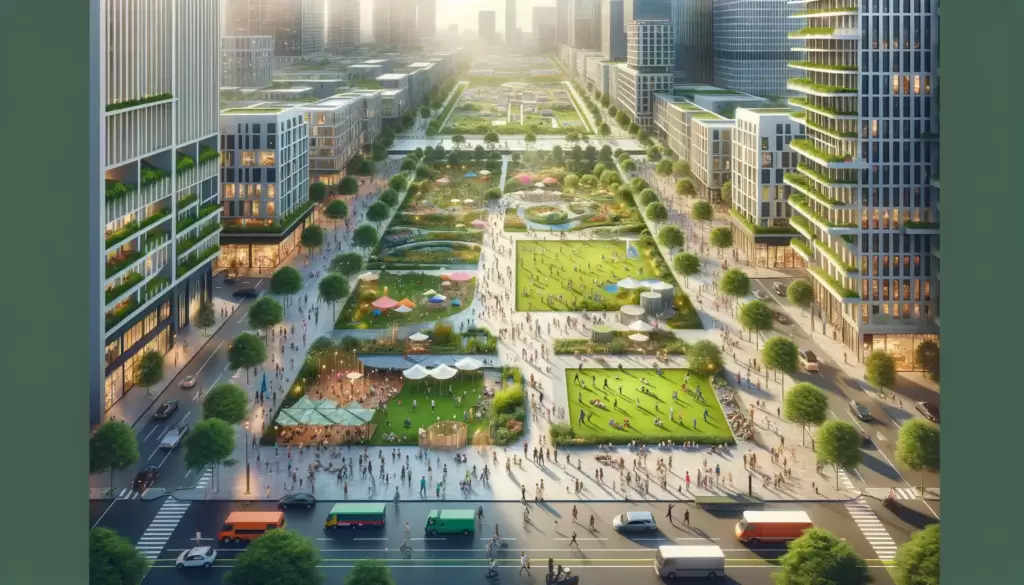
Table of Contents
Introduction: Defining public spaces in urban design
Public spaces are at the heart of urban design, serving as dynamic environments that facilitate social interactions, cultural exchange, and community engagement. These spaces can take various forms, from vibrant town squares and bustling marketplaces to serene parks and inviting waterfronts. What defines public spaces is their accessibility to all members of the community, regardless of socioeconomic status or background. As such, they play a crucial role in promoting inclusivity and fostering a sense of belonging within urban environments.
In addition to their social functions, public spaces contribute significantly to the aesthetic appeal and functionality of cities. They provide relief from the density of built structures by offering areas for leisure, relaxation, and recreational activities. When thoughtfully designed, these spaces have the potential to enhance the overall quality of life for urban residents while simultaneously contributing to sustainable development goals. By recognizing the multifaceted nature of public spaces in urban design, it becomes clear that they are essential components for creating cohesive and livable cities that prioritize human interaction and well-being.
Historical significance of public spaces
Public spaces hold immense historical significance as they have been central to human civilization for centuries. From ancient gathering places and market squares to modern parks and plazas, public spaces have played a crucial role in shaping the social, political, and cultural dynamics of cities. These spaces often serve as reflections of the values and aspirations of a society, with monuments and landmarks bearing witness to significant events and historical figures.
Moreover, public spaces have been arenas for social change and activism throughout history. From the civil rights movements in the United States to protests for democracy in various countries, public spaces have provided a platform for citizens to express their dissent, solidarity, or celebration. As such, these spaces carry layers of historical memory that contribute to a city’s identity and sense of place. Understanding this historical significance is essential in preserving these spaces as vital components of urban design that connect past, present, and future generations.
The evolution of public spaces also mirrors changes in societal values and urban planning practices over time. By studying the historical development of public spaces, urban designers can gain valuable insights into how these areas have adapted to changing needs while maintaining their essential role as civic gathering places. This understanding can inform contemporary efforts to create inclusive, accessible, and vibrant public realms that continue to enrich the lives of city dwellers while honoring their historical roots.
Social and community benefits of public spaces
Public spaces play a vital role in fostering social connections and nurturing community well-being. These areas offer a platform for diverse groups to converge, engage in dialogue, and exchange ideas. By providing a shared space for recreational activities, public spaces contribute to the promotion of physical and mental health among community members. Furthermore, these areas often serve as a canvas for cultural expression, offering opportunities for artistic performances, events, and celebrations that bring people together.
In addition to promoting inclusivity and interaction, public spaces also have the power to cultivate a sense of belonging within communities. When designed thoughtfully and inclusively, these areas can act as catalysts for social integration by breaking down barriers and encouraging collaboration among residents from different backgrounds. Furthermore, the presence of inviting public spaces can enhance neighborhood pride and identity while increasing civic engagement and overall social cohesion within urban environments.
Economic impact of well-designed public spaces
The economic impact of well-designed public spaces cannot be overstated. When a city invests in creating appealing and functional public spaces, it not only enhances the quality of life for its residents but also attracts visitors and businesses. These well-designed spaces often become vibrant hubs for social interactions, cultural activities, and various events, leading to increased foot traffic and consumer spending in surrounding areas. This phenomenon, known as the spillover effect, can result in higher property values and increased revenue for local businesses.
Well-designed public spaces also contribute to the overall economic competitiveness of a city. They create a sense of place and identity that can help differentiate a city from its competitors, attracting tourists, talent, and investment. Additionally, research has shown that access to green spaces or well-planned urban parks can lead to higher property values in adjacent neighborhoods. The presence of such public spaces fosters community pride and cohesion while boosting the desirability of living or working in close proximity—ultimately benefiting both residents and local businesses economically.
In essence, by investing wisely in well-designed public spaces, cities can experience tangible economic benefits alongside the less quantifiable yet equally important social and environmental advantages. These multifaceted impacts make it clear that public space design should be considered not just as an aesthetic component but as an integral part of urban planning with far-reaching implications for a city’s economic vitality.
Design considerations for effective public spaces
Designing effective public spaces in urban environments requires a thoughtful approach that considers the needs and experiences of diverse communities. One key consideration is the integration of nature within public spaces, allowing for greenery, water features, and natural elements to create a sense of calm and respite in busy urban settings. This not only enhances the aesthetic appeal but also promotes mental well-being and environmental sustainability.
Furthermore, the accessibility and inclusivity of public spaces are crucial design considerations. Incorporating universal design principles ensures that these spaces are welcoming to people of all ages, abilities, and backgrounds. By providing amenities such as ramps, seating options, tactile paths, and clear signage, public spaces become more navigable and enjoyable for everyone. Additionally, fostering opportunities for community engagement through flexible layouts and gathering areas encourages social interaction and a sense of belonging within the urban fabric.
In conclusion, effective public space design goes beyond aesthetics to encompass factors like sustainability, accessibility, inclusivity, and community engagement. When these considerations are prioritized in urban planning efforts, public spaces can truly serve as vibrant hubs where individuals from varied backgrounds can come together to socialize, exercise or simply enjoy moments of tranquility amidst the hustle-bustle of city life.
Sustainability and environmental impact of public spaces
Public spaces play a pivotal role in the sustainability and environmental impact of urban design. These areas can serve as green lungs within a city, offering natural respite from concrete jungles while mitigating the urban heat island effect. Incorporating elements such as trees, greenery, and water features in public spaces not only enhances their aesthetic appeal but also contributes to biodiversity and improved air quality. Moreover, sustainable materials and design principles can be employed to minimize the environmental footprint of these areas, from permeable paving for better stormwater management to renewable energy sources for lighting and amenities.
By integrating sustainable practices into public spaces, cities can reduce their overall carbon footprint while fostering a greater sense of community engagement. Designing with sustainability at the forefront encompasses everything from energy-efficient lighting and smart waste management solutions to eco-friendly landscaping that supports local flora and fauna. Additionally, incorporating renewable materials or repurposed resources into the construction of public spaces can significantly reduce their environmental impact, setting an example for responsible development across urban landscapes. Ultimately,
prioritizing sustainability in public space design ensures that these areas not only benefit current inhabitants but also contribute positively to the long-term health of our planet.
Conclusion: The future of public spaces in urban design
As we look to the future of public spaces in urban design, it has become increasingly clear that these spaces are crucial for enhancing community cohesion and well-being. With rapid urbanization and population growth, the demand for accessible and inclusive public spaces will only continue to rise. Therefore, city planners and architects must prioritize creating versatile and adaptable spaces that cater to diverse needs and activities.
The future of public spaces will also see a greater emphasis on sustainability and resilience. Designing green infrastructure, integrating natural elements, and promoting sustainable transportation options within these spaces will be essential in mitigating the environmental impact of urban development. Additionally, technology will play a significant role in transforming public spaces into smart environments that enhance user experiences while promoting connectivity and interaction among residents. Embracing innovative solutions such as interactive art installations, augmented reality experiences, or collaborative digital platforms can bring a new dimension to how people engage with their surroundings in urban areas.


